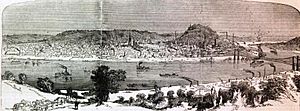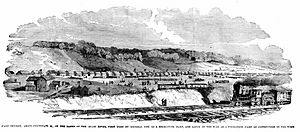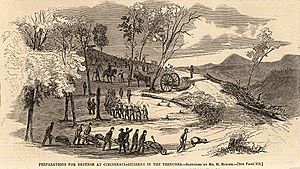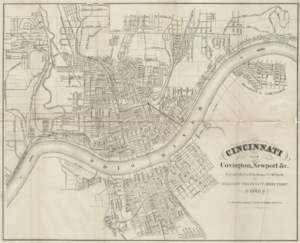Cincinnati in the American Civil War facts for kids
During the American Civil War, the city of Cincinnati, Ohio, was a very important place for the Union Army. Located on the Ohio River, it sent many supplies and soldiers to help the Union cause. Cincinnati was also the main headquarters for the Department of the Ohio. This group was in charge of defending the area and planning army attacks into Kentucky and Tennessee.
Contents
Cincinnati's Role at the Start of the Civil War
Before the Civil War, Cincinnati was a big part of the movement to end slavery. This was partly because it was a major city in Ohio, a free state, right across the river from Kentucky, a slave state. Many enslaved people escaped through Cincinnati on the Underground Railroad. Important abolitionists like Levi Coffin often spoke out against slavery here.
Cincinnati had different political ideas. Many new immigrants, especially Germans, supported the new Republican Party. In 1859, Abraham Lincoln visited Cincinnati. He debated Stephen Douglas about slavery. One local newspaper, the Cincinnati Daily Gazette, wrote a positive book about Lincoln. This book was used to help him win the 1860 election. However, another paper, the Cincinnati Daily Times, supported the South's right to leave the Union.
When the war began in 1861, many young men from Cincinnati joined the army. One famous group was the 9th Ohio Infantry. This was one of the first almost all-German units in the Union Army. The city gave $250,000 to help organize this group. People in Cincinnati also started helping soldiers by providing comfort and care. They finished the Good Samaritan Hospital for injured soldiers. Later, they opened a Soldiers' Home.
Cincinnati also became known for building gunboats and other ships for the Union Navy. These were made in shipyards along the Ohio River. The city also made boilers, armor, and cannons. Cincinnati was a key place for sending food like grain, pork, and beef, along with military supplies, to Union armies fighting in the Western part of the war.
Camp Dennison: A Training Hub
When the Civil War started, George B. McClellan, a leader from Cincinnati, chose a spot for a training center. He picked a flat area near Indian Hill, Ohio, about 17 miles from Cincinnati. This place became Camp Dennison. The Cincinnati area was a possible target for the Confederate Army because it was on the Ohio River and close to slave states like Kentucky.
More than 50,000 Union soldiers trained or left service at Camp Dennison. Sometimes, as many as 12,000 soldiers were there at once. After the Battle of Shiloh in April 1862, a military hospital was built at Camp Dennison. It had over 200 beds for wounded soldiers. The nearby Waldschmidt Cemetery was used for temporary burials of Union soldiers and Confederate prisoners. As the war continued, Camp Dennison became a very important base for Federal troops heading to the front lines.
Another important U.S. Army training camp near Cincinnati was Camp Harrison. It was six miles north of the city. Soldiers usually stayed at Camp Harrison for only a short time to train.
The 1862 Invasion Threat
In September 1862, Confederate General Henry Heth was sent to threaten Cincinnati. At the time, Cincinnati was the sixth-largest city in the United States. The mayor, George Hatch, declared martial law, which meant the military took control. Union General Lew Wallace quickly organized citizens to defend the city. He also formed the Black Brigade of Cincinnati, a group of African American volunteers.
Along eight miles of hills from Ludlow to Fort Thomas, Kentucky, volunteers and soldiers built trenches and other defenses. About 22,000 Union soldiers and 50,000 local volunteers, called "Squirrel Hunters," defended these positions. General Heth saw the strong defenses and decided not to attack. He stayed for one day and then left on September 13. General Wallace became known as the "Savior of Cincinnati" for his quick actions. The Squirrel Hunters then went back home.
By the end of the war, Cincinnati was protected by 27 forts and artillery positions. Six of these still exist today. Hooper Battery and Shaler Battery are open for people to visit.
Later Years of the War
In March 1863, General Ambrose Burnside became the new commander of the Department of the Ohio. He set up his headquarters in Cincinnati. During Morgan's Raid in July, troops from Camp Dennison responded to the Confederate cavalry attack led by General John Hunt Morgan. Gunboats from Cincinnati also helped defeat Morgan at the Battle of Buffington Island.
In December 1863, the United States Sanitary Commission opened the "Cincinnati Sanitary Fair" at the opera house. This event helped raise money and attention for soldiers' relief efforts. It had bazaars, food, art, lectures, and concerts. The Fair ran until April 1864 and collected $234,000 in donations. Most of this money, $175,000, came from people in Cincinnati.
Cincinnati was also where many military trials took place. People accused of helping the Confederate cause were tried here. One famous person convicted was Clement Vallandigham, an Ohio politician who opposed the war.
In the 1864 Presidential Election, people in Cincinnati voted strongly for President Lincoln. Even though General McClellan had strong ties to Cincinnati, he did not win Hamilton County.
When the war ended in 1865, Cincinnati became a major place for Federal troops to return home. Soldiers got off riverboats and traveled by roads and railroads back to Camp Dennison or their home cities to leave the service.
Important Cincinnatians in the War
- Nicholas Longworth Anderson
- Powhatan Beaty
- William Dennison
- William M. Dickson
- William Dwight
- James A. Greer
- George Hatch
- Andrew Hickenlooper
- William Haines Lytle
- Ormsby M. Mitchel
- Dr. John Moore
- Edward F. Noyes
- John P. Slough
- Thomas R. Hawkins
- Godfrey Weitzel
- August Willich
- Philander P. Lane
It's interesting to note that Ulysses S. Grant, a famous Union general and later president, was born near Cincinnati. He kept connections to the city. His favorite horse during much of the Civil War was named "Cincinnati."
Civil War Memorials and Places to Visit
Cincinnati has many places that remember the Civil War.
- The National Steamboat Monument in Cincinnati honors the hundreds of Ohio soldiers who died in the Sultana tragedy. These soldiers had been freed from Southern prison camps. An Ohio Historical Society marker also tells about the Sultana disaster, where about fifty Cincinnatians died. The ship itself was built in Cincinnati in 1862.
- Other markers and statues are around the city. Cincinnati has statues of Civil War-era composer Stephen Foster and Union general/President James A. Garfield. There are also two statues of President Lincoln.
- The Cincinnati Civil War Memorial Hall was built in 1908.
- Spring Grove Cemetery in Cincinnati is the burial place for 40 former Civil War generals. Salmon P. Chase, who was a very important member of Lincoln's team and later a Chief Justice of the US Supreme Court, is also buried there. A statue called "The Sentinel," showing a Union soldier on guard, was placed in Spring Grove Cemetery in 1865. It was one of the first Civil War monuments in Ohio.
- The city's importance as a stop on the Underground Railroad is remembered at the National Underground Railroad Freedom Center. This museum is right on the Ohio River. Its location is special because crossing the river from Kentucky to Ohio meant escaping slavery and reaching freedom.
- Each year, there are Civil War reenactments in the Cincinnati area. One event is "Civil War Days" in Sharon Woods Park.





